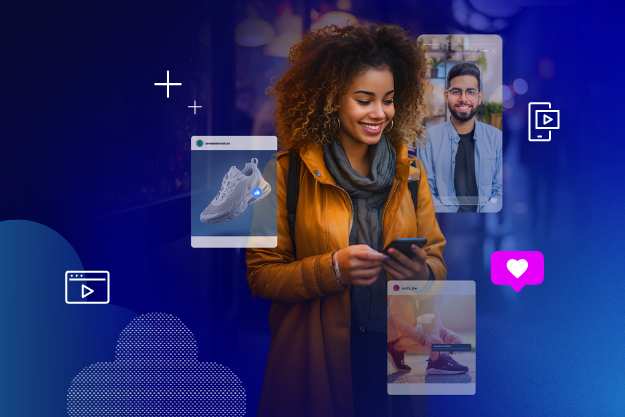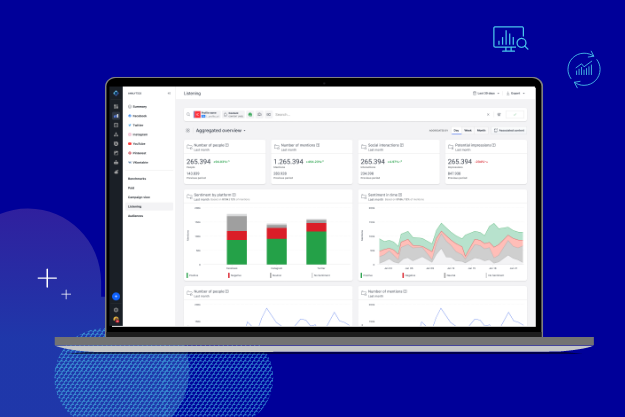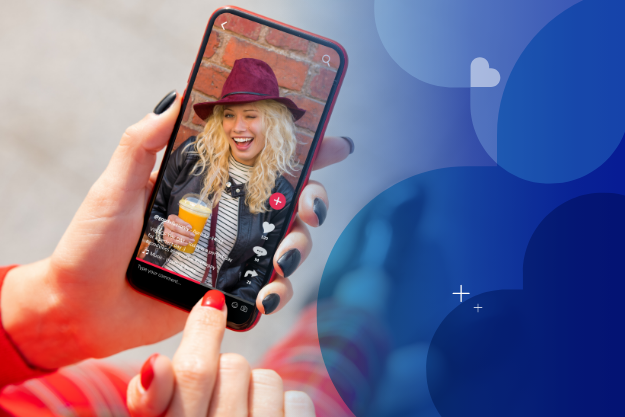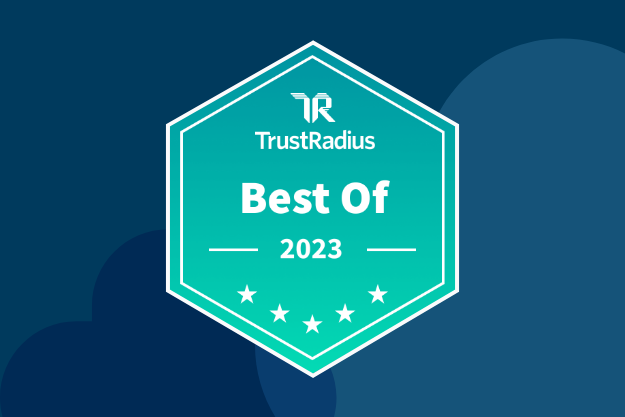If you want to engage modern consumers, your brand needs video content. That means your social media strategy is the stage – and occasional playground – to inform, influence, or inspire any target audience with engaging videos.
Where should you start? First, it's important to think beyond finding a Gen Zer on your staff who can dance or panic trying to assemble a sizable production investment from your already lean marketing budget. If those were your first thoughts, it's time to recalibrate what you know and how you think about social media videos.
Let's explore how to develop a social media video strategy that works for your brand, and consider a variety of ways video supports customer engagement and social proof across your entire customer journey.
Table of contents
Why does my brand need a social media video strategy?
A social media video strategy is a plan of action designed to promote your brand or products through videos on various social media platforms. Plus, it's also a structure to test, iterate, and amplify video content that works for the audiences you're trying to engage.
Modern consumers are saturated with digital content. Yet, each year, they seem to absorb more and more. According to Statista, adults in the United States – 18 years and older – consumed 503 minutes of digital media per day on average in 2023, which is a 175% increase over the past 10 years.
We're all spending a considerable amount of time on digital channels, and a good chunk of that attention is focused on social media. TikTok claimed the lion's share of daily use in 2023 with 53.8 minutes per day, and YouTube – which doesn't consider itself a social channel – followed closely behind with 48.7 minutes daily for the same audience of U.S.-based adults.
As your brand navigates how to deploy social video, this is what you're facing: Continual growth in digital content consumption and more competition for each consumer's eyeballs. It's going to be difficult to compete with Netflix, the latest true crime podcast, and the most recent Neil the Seal video on TikTok.
Open any social app on your phone, scroll, and count the number of static images versus videos featured. That's the sea of activity your brand is trying to comfortably stand out in, and to do that, you need a plan.
2 things to consider for your social media video strategy
Certainly, all marketing activity should come with an overall strategy, objectives, tactics, and a measurement plan. What makes social media videos different are two things: Resource allocation and attention span. All marketing activity deals with those challenges, but not quite in the same way that your video strategy will have to overcome.
1. Resource allocation
Not every video has to be a sizable production. And, as we'll cover later, there are many ways to share and source engaging video content to support your plan. But you're never going to make just one video – whether through an agency, a video production platform, a dedicated internal team, or your social media manager learning how to edit on the fly.
The production process can scale quickly as you write scripts or record, edit and review, and optimize your video for channel-specific considerations like aspect ratio and length. Video deliverables can be an execution that truly touches or unites your internal teams because of all the traditional steps involved from idea to execution.
Keep this in mind as you create your plan. You have options for simplified execution and scaled production, but video tends to require more steps and resources than traditional marketing tactics. And, more commonly, video is a catalyst for the goals of your internal partners, so this is a consideration you can tackle together.
2. Attention span
So, you've created some amazing videos, and they're ready to launch across your organic social media channels. But wait, no one seems to be watching them. What did you forget?
It really could be anything, and as we'll look at later, there are some things you should react to quickly and others that might be worth a longer analysis. Video is absolutely a medium that requires capturing your audience's attention quickly.
That doesn't mean every video needs to be less than 15 seconds long or should try to go viral. Our data shows that brands should diversify their video content to include long and short formats to increase engagement. Many brands are seeing improved engagement with longer videos – running from 26 to 90 seconds.
To account for attention span within your social media video strategy, you have to try things, learn from them, and apply those back into the plan. Making one video is the start of a conversation, but to keep your audience's attention, you have to keep that conversation going with a diverse mix of video content.
Within your plan, you might consider short, long, and live videos. As you evaluate performance, always ask yourself first if you made something worth your audience's attention.
What are the different types of social media videos?
Your content strategy comes to life on social media through these types of videos. Your channel strategy and the action you seek from an audience should determine what types of video you deploy, but it's fair to say it's worth trying various tactics within your plan. Consider each video type, its strengths, and how it can be used for social media engagement or other desired outcomes.
Video posts
This is your bread and butter for video engagement. These are pre-recorded videos shared on social media platforms. They can vary in length and style, ranging from short, snappy clips to longer, more in-depth content.
Video posts are used for a wide range of purposes, from showcasing products to storytelling. These types of posts have a unique advantage over static content in that they can capture attention, quickly make a necessary point, or simply bring a concept to life in an engaging way.
Live video
Livestreaming offers real-time video content to audiences. This format is popular for events, Q&A sessions, behind-the-scenes tours, and direct interaction with viewers. Live videos on platforms like Facebook, Instagram, and YouTube allow brands to connect with their audience more immediately and authentically.

Live video on Facebook, for example, can see four times as many interactions as a traditional video post, according to an Emplifi report. This is a tool that does require significant organization and preparation before brand use, though. Make sure you organize your approach.
GIFs
While not a traditional video format, GIFs are short, looping clips, often without sound, that can convey emotions, reactions, or highlight moments. They are widely used on social platforms for their ability to quickly grab attention and evoke a response, meaning they offer another way to deploy the strengths of video content without the full commitment of the viewer or the typical work required to create a video.
It's good to use GIFs to connect tone or message quickly within a social post. You should consider them both an avenue of potential fun and also an option for making fast, impactful visual points that a static image wouldn't be able to convey.
Stories
Popularized by Snapchat and later adopted by Instagram, Facebook, and others, Stories are short video clips or images that disappear after 24 hours. They are often used for more casual, spontaneous content and can include interactive elements like polls and questions. Stories aren't necessarily video, but this blend of channel and content should be considered within your activation.
Instagram Reels and TikTok videos
These are short-form videos that are particularly popular for their entertaining and creative content. Reels on Instagram and videos on TikTok often feature music, filters, and other creative effects, making them highly engaging for a younger audience.
It's extremely common to see TikTok videos shared through a Reel, which makes sense as Instagram's short-form video tool dominates all other social content with six times the reach of Stories and 55% more interaction than single-image posts.

Immersive video
Remember to keep options like 360-degree videos and virtual reality as potential touchpoints for your brand. These immersive video formats allow viewers to control their perspective for a more interactive experience. They're particularly useful for virtual tours or showcasing environments, and while there's more infrastructure involved in deployment, immersive video offers a compelling and unique experience for your audience.
Video ads
These are pieces of paid video content designed for advertising on social channels. They can appear in various formats, including pre-roll ads on YouTube, sponsored posts on social platforms, or as part of a Stories sequence.
Each of these types of social video content serves different purposes and can be effective in various contexts depending on the target audience, platform, or the action you want your audience to take.
Combining different types of video content in your strategy can provide a diverse and engaging experience for your audience, and more than likely, each type could play a role in a potential social video launch:
Your brand launches a new product featuring a video in a post on Instagram.
A brand social account teases a shorter version of the product video via Stories.
Reels featuring segments of the longer video posts are created and shared.
GIFs are created of key moments highlighting the impact or use of the new product.
A product expert takes questions live via streaming on Instagram or YouTube.

What are the best sources of social media video content?
Part of any effective social media video strategy is going to consider how you source the content for your plan. These types of videos will help capture your audience's attention, and if you plan carefully, are each likely to be valuable for other touch points across your customer journey:
Customer case studies and testimonials
Hearing from your customers is a reliable way to add an authentic source of content to your social media videos. Whether you interview or let a customer share their story in their own words, video is a powerful method of sharing what a static, text-based quote might not fully convey.
Video allows for emotion and impact to translate more effectively, so working customer stories into your mix is a foundational element of any plan. If you create these types of videos, they're probably just as useful in their original form or with a quick edit, for your website, sales, or customer success teams.
Perhaps your social video focuses on the story of the customer, while your testimonial version leans into a glowing recommendation. Regardless, someone singing your praises is valuable on any channel.
Explainer videos
These are informative videos that explain a product, service, or concept in an engaging and easy-to-understand way. They are often animated and can be used across various social media platforms.
Development of these – particularly with a video production tool – can be quick and efficient, and the impact is often significant. A 2020 study found that 84% of consumers say an explainer video convinced them to buy a product or service.
So, if you're thinking about making your thought leadership digestible or need a cost-effective solution to video, explainer videos can benefit your social and digital channels as an interactive way to convey your message.
Influencer videos
Influencers are a powerhouse for reaching audiences you hope to engage or convert. Identifying an influencer who is the right fit and vibe for your brand is key. But whoever you select is going to be a source of video content for your brand.
This can be as simple as reposting or resharing an influencer-created video or, more commonly in today's market, co-producing a series to help welcome new audiences to your brand and boost engagement with a voice those groups already trust. Whether the video is an opportunity for brand awareness or an endorsement, influencer marketing has great potential to support many of your marketing efforts.

Influencers tend to utilize video more than other content types, particularly on Instagram, according to Emplifi research. Brands and celebrities are also sharing on Reels more and more, recently seeing an increase in usage by 241% among brands and celebrities, meaning any influencer partnership is likely to yield powerful and effective video content for some touchpoint with your strategy.
Livestream events
This source is only slightly different from live video in that it's usually a larger-scale undertaking, like a livestream shopping event. Live video is a function of social media channels like Instagram and YouTube, whereas a livestream event could be hosted on an eCommerce channel to highlight a series of products around a major date like Black Friday. If your brand uses this type of effort, repurposing that content is a no-brainer.
Product videos
While planning your social media, don't forget one of the most important goals for your content: Show people what you do. For a software company, that can be as simple as a series highlighting your products and their features.
For service providers, there is a natural overlap between this effort and customer case studies, but just brainstorm on what to highlight in your key offering or use case. Videos, naturally, are good delivery methods for showing this in action.
User-generated content (UGC)
This encompasses videos created by customers or fans, showcasing their experiences with a brand or product. UGC can be a powerful tool for authenticity and building community, and it can impact your bottom line.
One more obvious benefit: it helps create content velocity. UGC can become an entire plan with its own considerations, including offering brands a way to show shoppable examples of their products in the consumer's hands. Plus, shoppers want to see your products in action before they buy them, which allows video-based UGC a way to serve customers and prospects beyond just your social channels.
Webinars and video podcasts
Longer-form video content that focuses on providing in-depth information, training, or educational material. These can be pre-recorded or live-streamed, and really, depending on your audience, these can also be video-based podcasts.
In whatever form your webinar takes, they're a considerable source for raw video to translate across all of your social channels or repackage into recaps, trend pieces, or just interesting clips.
5 steps to create a social media video strategy
There are more considerations for any social media video strategy than simply resource allocation and performance, but it's good to bake those into your decision process as you shape your plan.
If you're ready to develop it, make sure you have a social media strategy first, and, ideally, some understanding of who your audience or buyer's persona is for your brand's products and services.
1. Gather all available information to define your target audience.
Your overall social media strategy should fill in some of the key decisions you'll make as you build video into it. Here are a few examples:
Who is our audience?
What social media channels does our audience use?
Are those channels focused on brand awareness, demand generation, or customer support?
Are we investing in paid social or digital advertising on any specific social channels?
Once you have that information, you're ready. Here's how that plan can bring other marketing strategies to life when translated into your social media video strategy.
2. Define objectives or what actions you want your target audience to take
If you know who you're trying to engage, video content is an excellent way to motivate that audience to do something. So, to start your video strategy, detail your objectives for your audience and then map the action that the video can support. Here are some examples to consider:

You don't know that any one type of video will make customers engage or convert, but you can structure your required outcome with video content that tends to support that action, test, and iterate if it doesn't work. Your objective won't change, but your tactics can quickly and easily if you structure your plan accordingly.
3. Organize your available resources to produce video content
If you understand what you ideally want your audience to do, now we have to consider the catalyst for that action. Here's where you have to work within your available resources and translate those to what types of video content you can produce. Make sure you can answer these questions:
How do we source video? You will need to define a budget, process, and resources to create videos at scale. That can be as simple as a small dedicated team, or utilizing an influencer marketing or UGC solution. Video is a visual medium, and it's one that moves. You'll need to have a way to secure video files through interviews, stock assets, or product visuals.
How do we produce video? This could require an analysis of skill sets and marketing technology. Many of the social video channels – like TikTok – do offer helpful video editing capabilities, but those aren't necessarily helpful at scale. When in doubt, source video like UGC that removes the need for editing, or utilize a video production platform if your team doesn't have a mature operation.
4. Optimize activation around your channel strategy
Simply put, once you create a single video, it's likely to be valuable across other touchpoints and channels across your customer journey. So think about how each individual video can be repurposed or recycled to fulfill another need and be efficient with your available resources. You shouldn't think of one execution as a standalone landscape video, when you very likely could use a landscape version on another social channel.

This is where an enterprise-level social media management solution with the ability to share content across brand, digital, and eCommerce channels is helpful. You likely know the channels at this point, but here's how you should think about this as you create and activate optimized content:
5. Establish unified analytics to inform performance and iteration
It's time to find out if any of this is working — and be comfortable with evolution. You need easy ways to deploy between social and then measure through unified dashboards that help you understand performance in each unique touchpoint.
Yes, you're going to need to evaluate things like social engagement, views, number of views, and whether your audience watched the entire video. The more you can analyze social media videos, particularly against competitive benchmarks, the better you can plan. There are several factors to consider when measuring video performance, but here's a few to pay closer attention to:
Is your audience sharing your video?
Is your audience commenting on your video?
Is your audience watching more than the first 15 seconds?
What percentage of your audience is watching the entire video?
These sorts of indicators are helpful to identify what works and, if it works well, translate organic social into paid. Your work can boost any campaigns or paid activity because your measurement will have validated it already.
How to craft engaging social video content
Once your plan is in place, you actually have to produce. What you create, and how you create it depends on walking through the steps we discussed based on channel, type, and available assets. But more important than anything is to create content that resonates with your audience. Are you creating something worth their attention?
Videos should not only reflect your brand's personality but also speak to your audience's interests and needs. Here are some ways to think about it before beginning:
Be authentic: Audiences value authenticity. Share real stories, behind-the-scenes glimpses, and genuine customer experiences.
Focus on quality: High-quality visuals and sound make your content more engaging and professional, even if it means you have to scale back the volume of videos produced. Make each production more impactful through edits and cuts of quality work versus creating poorly sourced assets.
Call to action: Always include a clear call to action, telling viewers what to do next. You're making a video and trying to motivate an audience to do something. Just be clear as to what that is.
Experiment: Don't fear trying new things. With video, it might benefit you to have a partner like an influencer or UGC on your side to make sure that the experience is a bit more aligned with your audience.
How to get started with social video content
Think about video content within your larger marketing strategies. Regardless of how you execute, a video on social media can start or continue a journey for someone in the audience you're trying to reach.
If you're ready to consider video within your social media or social commerce strategy, let us know. We'd love to help you source, publish, measure, or monetize your video content.







































